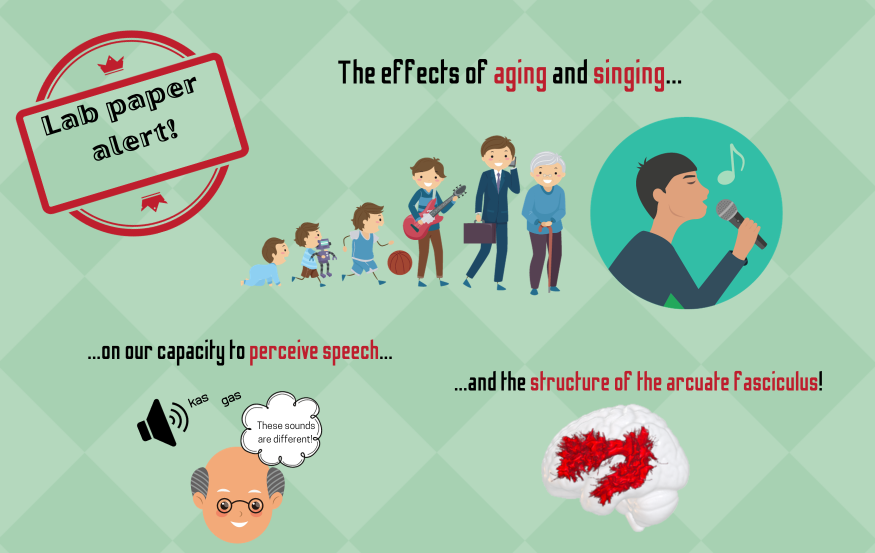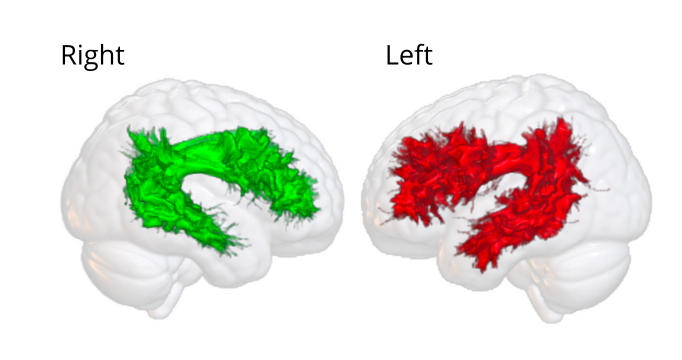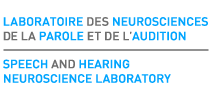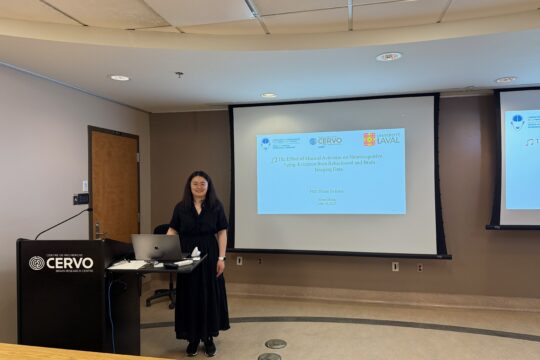
In this blog post, we’ll present to you a lab paper on aging and singing that has appeared in the journal Human Brain Mapping!
The first author of this article is Maxime Perron, a former master’s student in our lab. The article is co-authored by Pascale Tremblay, the lab director, and our collaborators from Sherbrooke, Maxime Descoteaux and Guillaume Theaud, who are experts in white matter! Several former members of the lab also contributed to the project: Julie Poulin, Émilie Belley, Lisa-Marie Deschênes, Anne-Christine Bricaud, Elena Vaccaro, and Antoine Halbaut. The complete article is available on open access!
This article presents the results of a research project that studied the relationship between the ability to perceive speech in noise and the structure of a white matter bundle in the brain, namely the arcuate fasciculus (see Figure 1). This bundle connects several regions of the brain that, together, are believed to be involved in the perception and production of speech. The project focused on people who do or do not engage in amateur singing.

Figure 1. Example of arcuate fasciculus in the right and left hemispheres.
In total, 41 male and female singers, as well as 43 non-singers, participated in the study. These individuals ranged in age from 20 to 87 years. They underwent an MRI examination (specifically, diffusion MRI, which provides images of white matter bundles) and a syllable listening test in the soundproof room of our lab. During this test, participants had to determine whether pairs of syllables they heard were identical (e.g., kas – kas) or different (e.g., kas – gas) while simultaneously hearing people in the background, somewhat like in a restaurant where we must ignore people talking at nearby tables (which can sometimes be challenging, especially if they’re interesting!).
Here is a summary of the main results obtained:
- Aging is associated with a decrease in the ability to perceive speech in noise, both in singers and non-singers;
- This decline is accompanied by deterioration in the structure of the arcuate fasciculus;
- The structure of the arcuate fasciculus differs between singers and non-singers;
- However, these differences are not associated with a better ability to perceive speech in noise among singers.
In some studies, musical activities have been associated with better speech perception abilities (for a literature review on the subject, we suggest reading Coffey et al., 2017, linked below). However, the scientific literature on this topic is very heterogeneous, and it is still unclear whether engaging in musical activities enhances speech perception in noise. There is particularly limited data on singers. That’s why Elisabeth Maillard recently undertook a systematic review of all this literature and a meta-analysis. This article was published in 2023 in Current Research in Neurobiology!
Finally, even though the singers in our study were not at an advantage in perceiving speech in noise, the results nevertheless indicate that singing has the potential to promote neuroplasticity mechanisms throughout life! Moreover, other skills could benefit from singing practice, such as voice control, articulation, central auditory processing, and many more. We are currently conducting other studies involving singers and non-singers to have a more comprehensive picture of the effects of singing.
Link to the full article: https://onlinelibrary.wiley.com/doi/epdf/10.1002/hbm.25416
Reference:
Coffey, E. B. J., Mogilever, N. B., & Zatorre, R. J. (2017). Speech-in-noise perception in musicians: A review. Hear Res, 352, 49-69. doi:10.1016/j.heares.2017.02.006
Suggested readings:


